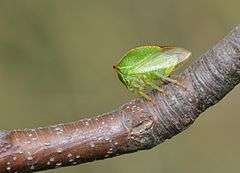Buffalo treehopper
| Stictocephala bisonia[1] | |
|---|---|
 | |
| Stictocephala bisonia | |
| Scientific classification | |
| Kingdom: | Animalia |
| Phylum: | Arthropoda |
| Class: | Insecta |
| Order: | Hemiptera |
| Suborder: | Auchenorrhyncha |
| Family: | Membracidae |
| Subfamily: | Membracinae |
| Genus: | Stictocephala |
| Species: | S. bisonia |
| Binomial name | |
| Stictocephala bisonia Kopp & Yonke, 1977 | |
The buffalo treehopper (Stictocephala bisonia) is a species of treehopper native to North America. It is also sometimes classified as Ceresa bisonia.[2]
Appearance
Buffalo treehoppers are a bright green color and have a somewhat triangular shape that helps camouflage them so as to resemble thorns or a twiggy protuberance.[1][3][4] It gets its name from the vague resemblance of its profile to that of an American bison.[3] They grow to 6 to 8 millimeters (0.24 to 0.31 in) long and have transparent wings.[3][4]
Life cycle

S. bisonia mates during the summer months.[4] Males attract females with a song that, unlike similar songs used by cicada and crickets, are outside the sonic range audible to humans.[4] Females lay eggs from July to October using a blade-like ovipositor.[3][4] Up to a dozen eggs are laid in each slit made by the female.[3][4]
Nymphs emerge from the eggs the following May or June.[3][4] The nymphs, which resemble wingless adults, but have a more spiny appearance, descend from the trees where they hatched to feed on grasses, weeds, and other nonwoody plants.[3][4]
They molt several times in the following month and a half until they have reached adulthood.[4] Then they return to the trees to continue their life cycle.[4]
Feeding
Both adult and immature buffalo treehoppers feed upon sap using specialized mouthparts suited for this purpose.[4] Black locust, clover, elm, goldenrod, and willow are among their favorite food sources.[4] It is also an occasional pest of fruit trees and is harmful to young orchard trees, especially apple trees.[4] It has become an invasive species in some parts of Europe.[2]
References
- 1 2 Jackman, John A. (2001-08-10). "Buffalo Treehopper". Texas Cooperative Extension. Texas A&M Entomology Department. Retrieved 2008-07-16.
- 1 2 "buffalo treehopper", Encyclopædia Britannica (Online ed.), Encyclopædia Britannica, Inc., 2008, retrieved 2008-07-14
- 1 2 3 4 5 6 7 "Buffalo Treehopper". Pennsylvania Tree Fruit Production Guide. Pennsylvania State University, College of Agricultural Sciences. 2008-06-05. Retrieved 2008-07-16.
- 1 2 3 4 5 6 7 8 9 10 11 12 13 Moran, Mark (2004-04-05). "Buffalo Treehopper: Stictocephala bisonia". Study of Northern Virginia Ecology. Fairfax County Public Schools. Retrieved 2008-07-14.
External links
https://500px.com/photo/124407801/stictocephala-bisoña-buffalo-treehopper-by-felipe-vilarroya
| Wikimedia Commons has media related to Stictocephala bisonia. |